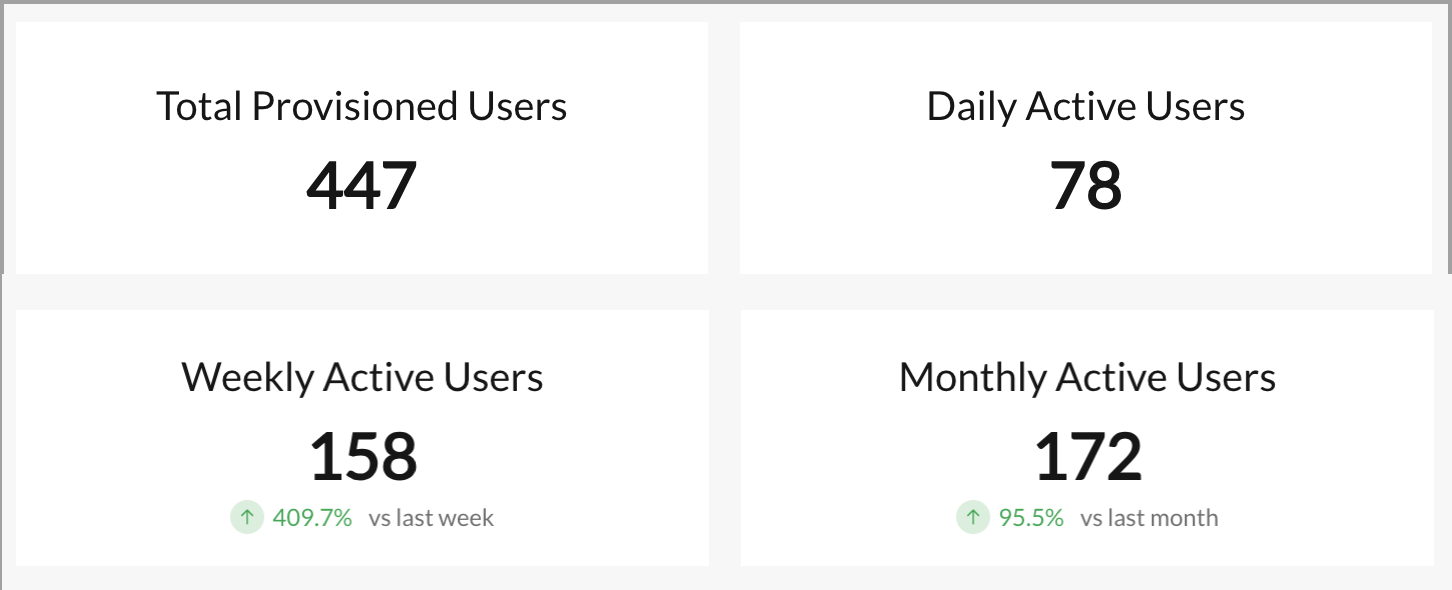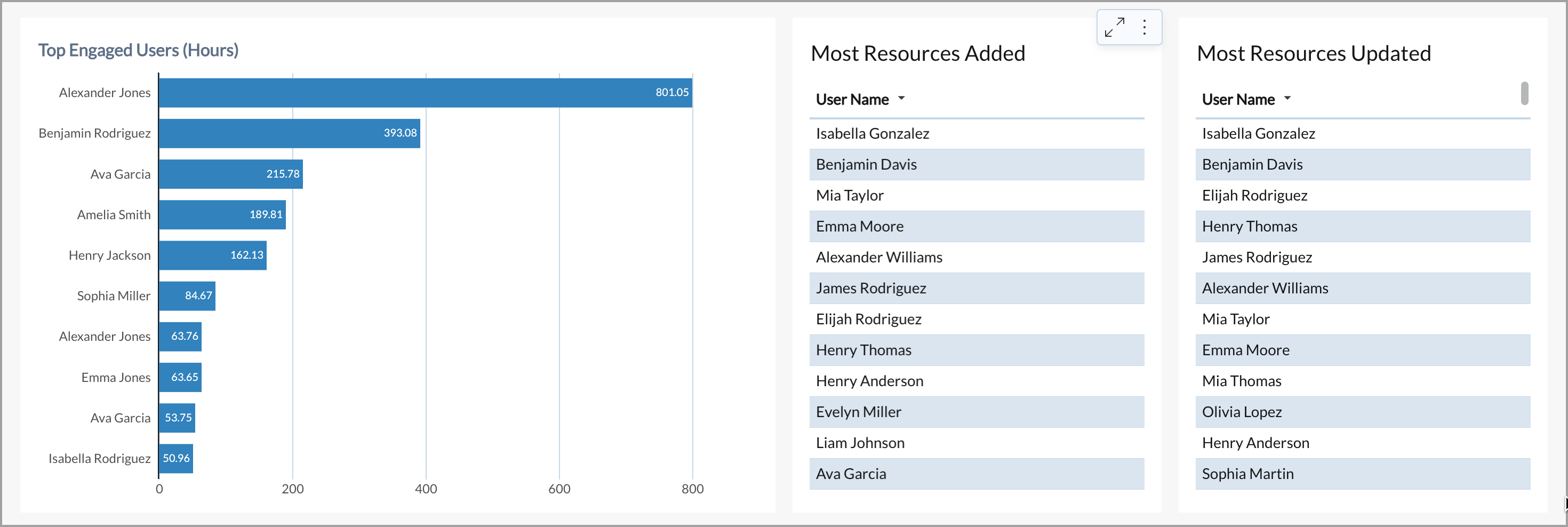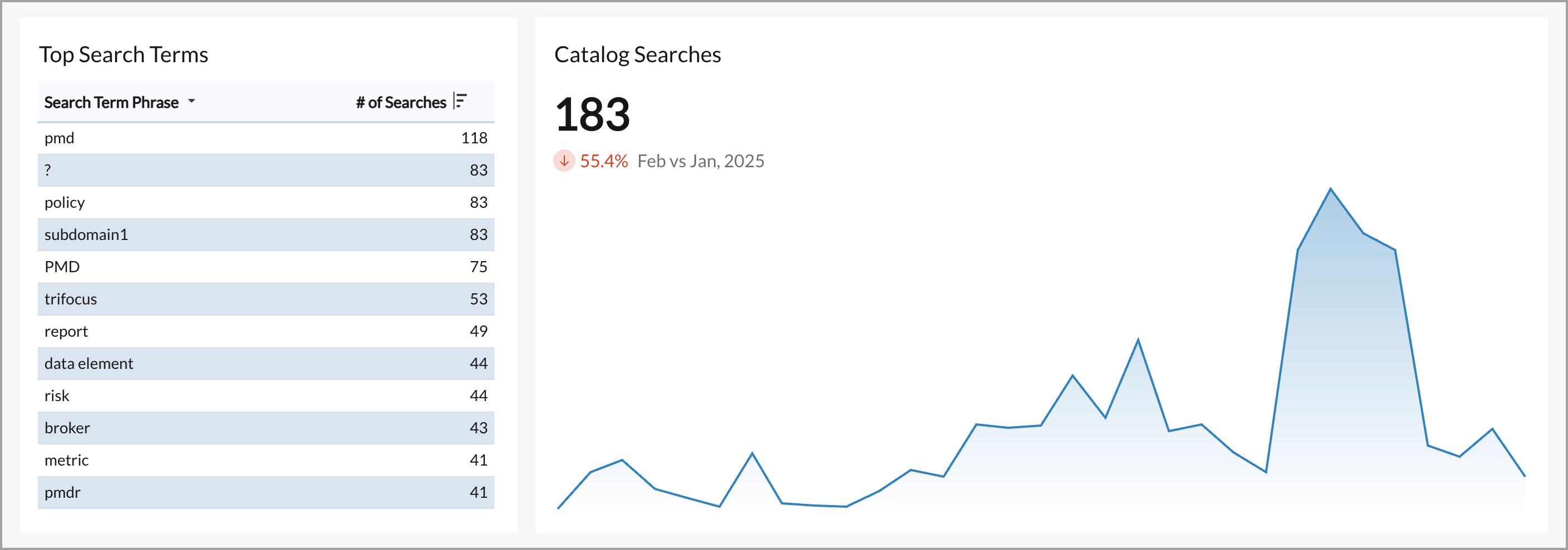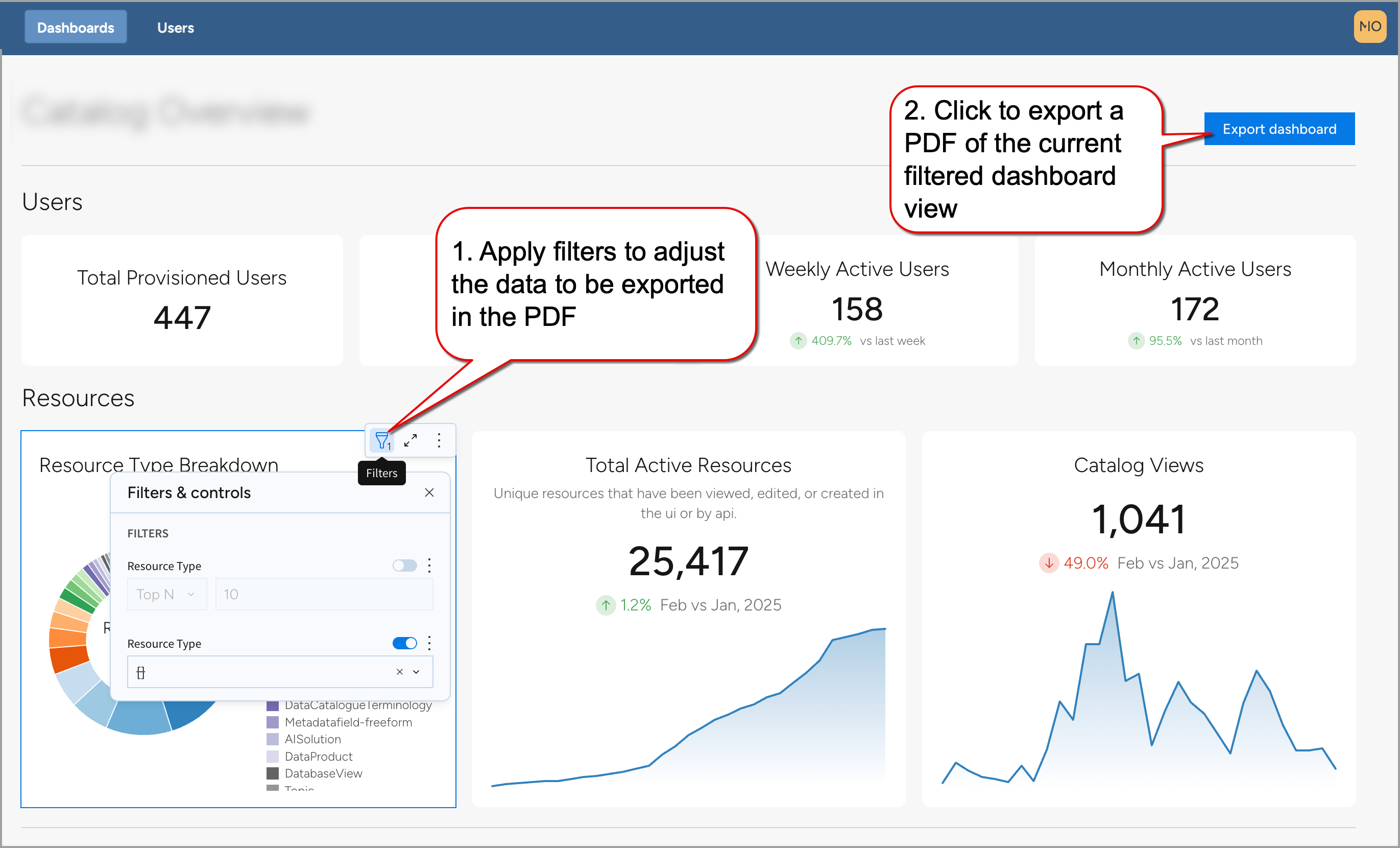Viewing catalog overview dashboards
Catalog Overview Dashboards provides a high-level summary of user activity, resource management, and search engagement on data.world. Use this dashboard to:
Monitor user activity across different timeframes to track engagement and platform adoption.
Analyze resource distribution and usage to understand how data is created, accessed, and managed.
Track search interactions to assess how users are discovering and engaging with catalog content.
Key catalog dashboards
Explore the following dashboards with key metrics available on the Catalog Overview dashboard page.
Users
This section helps monitor platform adoption and user engagement trends. For detailed user dashboards, see Viewing users dashboards.
Dashboard | Details | Source for the dashboards |
|---|---|---|
Total Provisioned Users | Displays the total number of users onboarded to the platform, helping track growth and adoption. |
|
Daily Active Users | Shows the number of users who have logged in on the current date, indicating real-time engagement levels. |
|
Weekly Active Users | Highlights the number of users active over the past seven days, providing insights into short-term engagement trends. |
|
Monthly Active Users | Displays active users over a 28-day period, helping analyze long-term retention and usage patterns. |
|

Resources
Understand how resources are distributed and accessed across the platform. For detailed resources dashboards, see Viewing resources dashboards.
Dashboard | Details | Source for the dashboards |
|---|---|---|
Resource Type Breakdown | Displays a visual representation of resource types, providing insights into data diversity and structure. |
Notes: The data source represents only resources that are associated with UI activity. It is not a complete record of catalog resources. |
Total Active Resources | Highlights the number of unique resources viewed, edited, or created, helping measure catalog growth. |
Notes: The counts are limited to resources that have been viewed, edited, or created in the UI. |
Catalog Views | Shows the total number of views for catalog content, offering insights into resource engagement trends. |
|

Engagement
Analyze user interaction with resources and time spent on a platform. For detailed engagement dashboards, see Viewing engagement dashboards.
Dashboard | Details | Source for the dashboards |
|---|---|---|
Top Engaged Users (Hours) | Highlights users with the highest engagement time, helping recognize power users. |
|
Most Resources Added | Lists users who have contributed the most new resources, measuring content creation activity. |
Notes: The data source is limited to resources added via UI operations |
Most Resources Updated | Shows users who have made the most updates, tracking active content management efforts. |
Notes: The data source is limited to resources added via UI operations |

Search
Evaluate how users interact with search functionalities to discover catalog content. For detailed search dashboards, see Viewing search dashboards.
Dashboard | Details | Source for the dashboards |
|---|---|---|
Top Search Terms | Lists the most commonly used search phrases, providing insights into user intent and trending topics. |
|
Catalog Searches | Displays the number of searches performed within the catalog, showing trends in data discovery and exploration. |
|

Exploring catalog data dashboards
To explore catalog data on the dashboards:
Go to the Dashboards page and click Catalog Overview in the left pane.
The dashboard displays key user, resource, and search activity metrics.
To export the entire dashboard view, click the Export dashboard button. This captures a snapshot of all visible widgets and applied filters as a PDF — ideal for sharing, reporting, or archiving. For details, see Exporting dashboards
To export data or visualizations from individual dashboards, hover over any widget and click the Three-dot menu > Export. Available formats include CSV, JSON, Excel, PNG, and others.
Click the Three dot menu in any dashboard and select Refresh data to update the dashboard.
To expand a specific dashboard, hover over it and click Maximize Element. The expanded view shows a detailed view of the underlying data of the dashboard elements.
Filtering and analyzing catalog data
Each dashboard includes filter options to refine data and analyze catalog activity in detail.
To filter and analyze catalog data:
To apply a filter on all dashboards on the page, click the Global Filters button. In the Global Dashboard Filters window, select from the following:
Select Exclude Users by Selection to remove specific users from the dashboards.
Use Filter Users by Email Text to filter out users by specific criteria.
To use the filters for specific dashboard, hover over a dashboard and click Filters.
Use the following filtering options for the Users dashboards:
Date: Define a timeframe for which data will be displayed. For example, selecting a specific date for the Weekly Active Users dashboard will display data for the seven days preceding the selected date.
Check Include Today to incorporate the latest data.
Use the following filtering options for the Resource Type Breakdown dashboard:
Resource Type: Adjust the number of displayed results to expand or narrow the list.
Resource Type: Select the type of resources to exclude from the list.
Use the following filtering options for the Top Engaged Users (Hours) dashboard:
Lifetime Engagement Hours: Adjust the number of displayed users beyond the default top 10 to expand or narrow the list.
Use the following filter options for the Search dashboards:
Search Type: Select the type of searches displayed.
Number of Searches: Adjust the number of displayed results beyond the default top 15 to expand or narrow the list. This settings applies to Top Search Terms dashboard.
Sort and organize data:
Click the Column header name in the dashboard to access sorting options. Use available sorting options to arrange data effectively.
Click Column details to view summaries and insights about a specific column.
Copying and analyzing data:
Right-click any value inside a table and select Copy to clipboard to copy specific data values.
To view total values, right-click and select Show all totals. For example, total resources added by the users.
Use sorting and filtering tools to focus on specific activity and high-value users.
Exporting dashboards
You can export the entire dashboard view as a PDF file. This is useful for sharing dashboard insights with others, archiving reports, or including snapshots in presentations.
The export captures all visible charts and widgets on the page, along with any filters that are currently applied.
To export the dashboard as a PDF:
Apply filters to customize the data shown in the export. For example, you can filter by date range, resource type, or specific metrics to tailor what appears in the final PDF.
Click the Export dashboard button at the top of the page.
The PDF file is saved automatically to your local device. The export reflects the current visible state of the dashboard, including all applied filters and settings.
